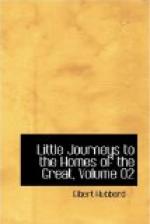Charlotte Bronte knew all about Jane Austen, and her example fired Charlotte’s ambition. Both were daughters of country clergymen. Charlotte lived in the North of England on the wild and treeless moors, where the searching winds rattled the panes and black-faced sheep bleated piteously. Jane Austen lived in the rich quiet of a prosperous farming country, where bees made honey and larks nested. The Reverend Patrick Bronte disciplined his children: George Austen loved his. In Steventon there is no “Black Bull”; only a little dehorned inn, kept by a woman who breeds canaries, and will sell you a warranted singer for five shillings, with no charge for the cage. At Steventon no red-haired Yorkshiremen offer to give fight or challenge you to a drinking-bout.
The opposites of things are alike, and that is why the world ties Jane Eyre and Jane Austen in one bundle. Their methods of work were totally different: their effects gotten in different ways. Charlotte Bronte fascinates by startling situations and highly colored lights that dance and glow, leading you on in a mad chase. There’s pain, unrest, tragedy in the air. The pulse always is rapid and the temperature high.
It is not so with Jane Austen. She is an artist in her gentleness, and the world is today recognizing this more and more. The stage now works its spells by her methods—without rant, cant or fustian—and as the years go by this must be so more and more, for mankind’s face is turned toward truth.
To weave your spell out of commonplace events and brew a love-potion from every-day materials is high art. When Kipling takes three average soldiers of the line, ignorant, lying, swearing, smoking, dog-fighting soldiers, who can even run on occasion, and by telling of them holds a world in thrall—that’s art! In these soldiers three we recognize something very much akin to ourselves, for the thing that holds no relationship to us does not interest us—we can not leave the personal equation out. This fact is made plain in “The Black Riders,” where the devils dancing in Tophet look up and espying Steve Crane address him thus: “Brother!”
Jane Austen’s characters are all plain, every-day folks. The work is always quiet. There are no entangling situations, no mysteries, no surprises.
Now, to present a situation, an emotion, so it will catch and hold the attention of others, is largely a knack—you practise on the thing until you do it well. This one thing I do. But the man who does this thing is not intrinsically any greater than those who appreciate it—in fact, they are all made of the same kind of stuff. Kipling himself is quite a commonplace person. He is neither handsome nor magnetic. He is plain and manly and would fit in anywhere. If there was a trunk to be carried upstairs, or an ox to get out of a pit, you’d call on Kipling if he chanced that way, and he’d give you a lift as a matter of course, and then go on whistling with hands in his pockets. His art is a knack practised to a point that gives facility.




